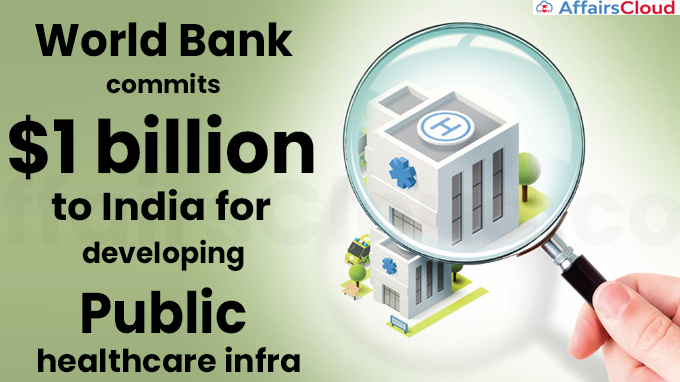 On March 3, 2023, Government of India (GoI) and World Bank (WB) signed 2 complementary loans of $500 million Public Health Systems for Pandemic Preparedness Program (PHSPP) and $500 million Enhanced Health Service Delivery Program (EHSDP) to support and improve India’s healthcare infrastructure.
On March 3, 2023, Government of India (GoI) and World Bank (WB) signed 2 complementary loans of $500 million Public Health Systems for Pandemic Preparedness Program (PHSPP) and $500 million Enhanced Health Service Delivery Program (EHSDP) to support and improve India’s healthcare infrastructure.
- The loan agreements were signed by Rajat Kumar Mishra, Additional Secretary, Department of Economic Affairs and Auguste Tano Kouamé, World Bank India country director.
Key Points:
i.Through the combined financing of USD 1 billion (about Rs 8,200 crore), the WB will support India’s flagship Pradhan Mantri-Ayushman Bharat Health Infrastructure Mission (PM-ABHIM), which was launched in October 2021, to improve the public healthcare infrastructure across India.
ii.Both the PHSPP and EHSDP loans which will be obtained from the International Bank for Reconstruction and Development (IBRD) (The financial institution which is a part of the World Bank Group) have a final maturity of 18.5 years including a grace period of 5 years.
iii.One of the loans would prioritise health service delivery in 7 states including Andhra Pradesh, Kerala, Meghalaya, Odisha, Punjab, Tamil Nadu, and Uttar Pradesh.
Purpose of the two Loans:
i.The two Programs will support both the Center and the States for development of more accessible, high-quality, and affordable health services.
ii.They are also supporting India’s decision to increase the resilience and preparedness of the country’s health systems against future pandemics.
iii.$500 million PHSPP:
- The program will support the GoI’s efforts to prepare India’s surveillance system to detect and report epidemics of potential international concern, ensure rapid response, and prevent emergence of pathogens.
- It will also improve India’s capacity to detect pathogens, including zoonotic diseases, to inform India’s bio-security response and commercialization of new technologies to prevent, detect or treat infectious diseases.
- It will strengthen coordination and capacity of core public health institutions to deliver high-quality results.
iv.$500 million EHSDP:
- Service delivary could be improved under the EHSDP by redesigned primary health care model. Under which the household access to primary healthcare facilities will be improved through regular household visits and risk assessment of noncommunicable diseases.
- Quality of care will be improved by supporting the National Quality Assurance Standards certification across Health and Wellness Centers (HWCs), which will transform health sector governance and accountability by strengthening implementation capacities at the district level.
India’s performance in health care:
i.According to the World Bank estimates, India’s life expectancy was increase to 69.8 in 2020 from 58 in 1990 and it is higher than the average for the country’s income level.
ii.The achievement in access to skilled birth attendance, immunizations, and other priority services are evident from the values such as the under-5 mortality rate of 36 per 1,000 live births, infant mortality rate of 30 per 1,000 live births, and maternal mortality ratio (103 per 100,000 live births)
- The rates are all close to the average for India’s income level
Recent Related News:
According to the “Toolkit on Enabling Gender Responsive Urban Mobility and Public Spaces in India,” released by the World Bank (WB), women are among the most frequent users of public transportation in India, accounting for 84% of all women journeys.
About World Bank:
World Bank Group President – David Malpass
Headquarters – Washington, DC, USA
Establishment – 1944




